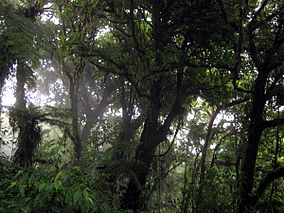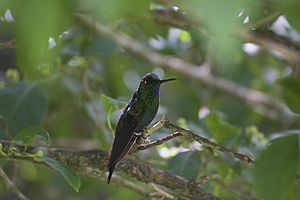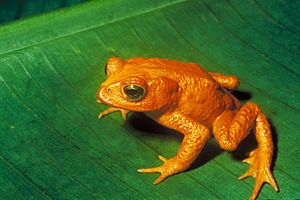Monteverde Cloud Forest Reserve facts for kids
Quick facts for kids Monteverde Cloud Forest Reserve |
|
|---|---|
| Reserva Biológica Bosque Nuboso Monteverde | |

Monteverde Cloud Forest Reserve
|
|
| Location | Puntarenas and Alajuela, Costa Rica |
| Nearest city | Monteverde |
| Area | 10,500 ha (26,000 acres) |
| Established | 1973 |

The Monteverde Cloud Forest Reserve (which means "Green Mountain Biological Reserve" in Spanish) is a special nature area in Costa Rica. It is located in the Puntarenas and Alajuela provinces, near the town of Monteverde. This amazing reserve was started in 1972 and covers over 10,500 hectares (about 26,000 acres) of unique cloud forest.
About 70,000 people visit the reserve each year. It has six different natural areas, and 90% of them are untouched, old-growth forest. The reserve is home to an incredible variety of life, called biodiversity. You can find over 2,500 kinds of plants here, including more orchid species than anywhere else in the world! There are also 100 types of mammals, 400 kinds of birds, 120 types of reptiles and amphibians, and thousands of different insects. This rich environment attracts both scientists and tourists.
Contents
History of the Monteverde Cloud Forest Reserve
How Monteverde Got Its Name: The First Farmers (1950s)
In 1951, about 11 families of Quakers from Alabama moved to Costa Rica. They wanted to live as farmers. They chose Costa Rica because it had just gotten rid of its army a few years earlier. This was important to the Quakers because their beliefs include being pacifists, meaning they do not believe in war. They wanted to avoid being forced to join the army during the Korean War. These Quaker families named the area Monteverde, which means "Green Mountain," because the plants stay green all year round.
Biologists Discover Monteverde (1960s)
Scientists began to notice Monteverde in the 1960s. Even though it was hard to do research there because there were no proper buildings or tools, these early biologists started studying the area. They have continued to document its amazing nature, and some even still live there today.
In 1968, Dr. Joseph Tosi and Dr. Leslie Holdridge visited Monteverde. They worked for the Tropical Science Center, a group focused on protecting tropical areas. They met Hubert Mendenhall, a leader in the Quaker community. He showed them the beautiful, untouched forests around their community. After their visit, the scientists told the Quakers that keeping these forests healthy was important. The forests would help protect their water sources and act as windbreaks against strong winds, keeping their fields and homes safe.
Protecting the Forest: Conservation Efforts Begin (1970s)
In 1972, a student named George Powell came to Monteverde to study birds for his doctoral research. He found that the animals and their homes were perfect for scientific study. George was amazed by the incredible richness of the cloud forests. He was especially concerned about the golden toad, a unique animal found only there. He also worried about hunters and people illegally settling on the land.
The Guacimal Land Company offered to donate 328 hectares (about 810 acres) of land if George could find a group to take care of it. George even used his own money to buy out some of the illegal settlers. He hoped to create a small protected area. At that time, Costa Rica had few national parks. The Tropical Science Center (TSC) was interested in creating private protected areas for research and education. They wanted each area to represent a different natural part of the country.
The TSC quickly became interested in George's idea. In April 1973, they bought the 328 hectares for a very small price, less than one U.S. dollar. Along with George Powell, Costa Rican biologist Adelaida Chaverri and wildlife expert Christopher Vaughn helped make this private reserve happen. Adelaida Chaverri, Dr. Joseph Tosi, and other TSC members became key supporters of what is now the Monteverde Cloud Forest Reserve.
In 1975, 431 people visited the new reserve, mostly scientists and bird watchers. A few years later, there still wasn't a hotel for visitors. So, a local Quaker woman, Mrs. Wood, started a small bed-and-breakfast in her home for people visiting the area.
Early Tourism and Challenges (1980s)
The number of visitors grew a lot, from 2,700 in 1980 to over 40,000 in 1991. The reserve also grew bigger during these years. However, something sad happened: the famous golden toad, which was only found in Monteverde, disappeared. About 40% of all amphibians in Monteverde also died out. This was due to a deadly fungal disease called Chytridiomycosis.
Monteverde Today (1990s to Present)
Today, more than 70,000 people visit the Monteverde Cloud Forest Reserve every year. They come from all over the world to experience its incredible biodiversity and natural beauty.
Life in the Cloud Forest: Biology
Plants of Monteverde (Flora)
The Monteverde region is famous for its amazing plant life. A special type of plant called an epiphyte makes up 29% of all plants here, with 878 different kinds! Epiphytes are plants that grow on other plants, like trees, but they don't harm them. They get their water and nutrients from the air and rain.
Monteverde is also known for having the largest number of orchid species in the world. There are over 500 known types of orchids here. When scientists explored the reserve, they even discovered 34 new orchid species that had never been seen before!
Animals of Monteverde (Fauna)
The Monteverde Cloud Forest is home to many interesting animals. It has 161 different kinds of amphibians and reptiles. The reserve was once the only home of the famous golden toad (Incilius periglenes), a bright orange toad that sadly disappeared in 1989.
Many birds live in Monteverde. About 91 (21%) of the bird species are migratory birds. This means they travel long distances. They reproduce in North America and either pass through Monteverde during their journey or spend the winter here. Some birds, like the swallow-tailed kite, the piratic flycatcher, and the yellow-green vireo, actually have their babies in Monteverde and then fly to South America when it's not breeding season.
The beautiful resplendent quetzal moves between higher and lower parts of the mountains depending on the season. The three-wattled bellbird also moves around. It reproduces near the Continental Divide from March to June, and then moves down the Pacific side of the mountain in August and September.
Most of the birds in Monteverde eat insects. However, the plants in the region also offer a wide variety of fruits. The epiphytes are very important food sources for both fruit-eating and insect-eating birds. Globally, the cloud forests of Monteverde are home to ten bird species that are considered endangered by Birdlife International because they have very small habitats worldwide.
Monteverde also has many mammals, including animals found in both North and South America. The mammals here include six types of marsupials, many kinds of bats (at least 58 species!), three types of primates (like monkeys), and many other interesting creatures like sloths, armadillos, rabbits, squirrels, porcupines, wild pigs, deer, and even tapirs.
Visitor Facilities and Activities
The Monteverde Cloud Forest Reserve has several facilities for visitors. There is a bus service that runs five times a day from Monteverde and Santa Elena. The reserve also has a lodge where up to 47 visitors can stay overnight. You can find a small restaurant and a gift shop there too.
Near the reserve, you can visit the Monteverde Nature Center. This center has an information area, a serpentarium (for snakes), a frog pond, a bat jungle, and butterfly gardens. Inside the reserve, there are well-kept trails for walking. You might also find suspension bridges and zip-lines for adventure! Sometimes, horseback riding tours are also arranged.
Images for kids
See also
 In Spanish: Reserva biológica Bosque Nuboso Monteverde para niños
In Spanish: Reserva biológica Bosque Nuboso Monteverde para niños








